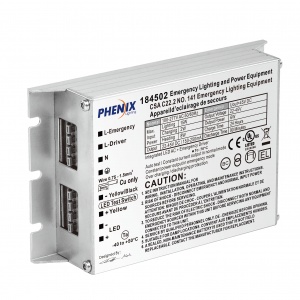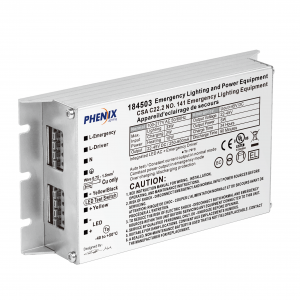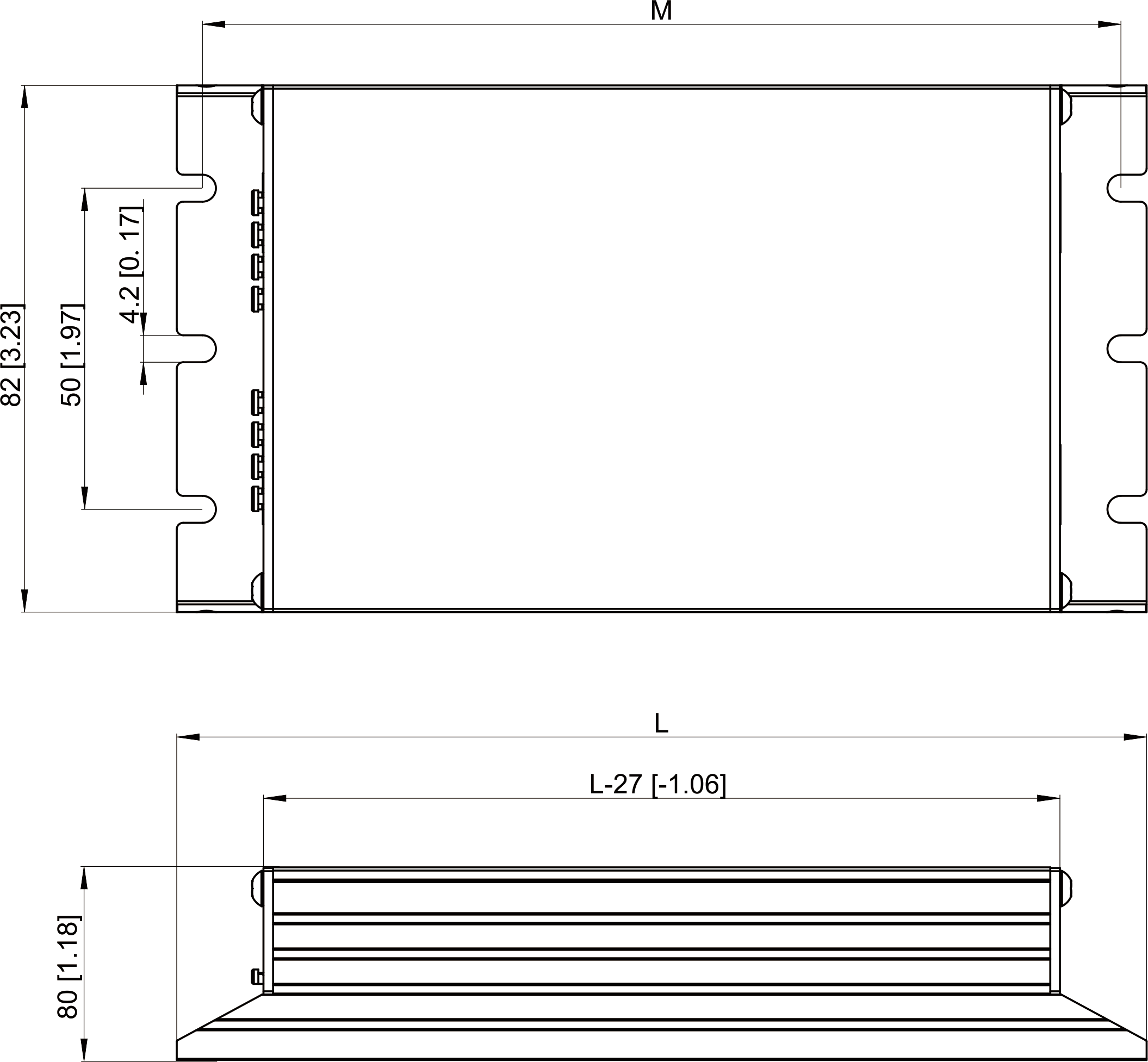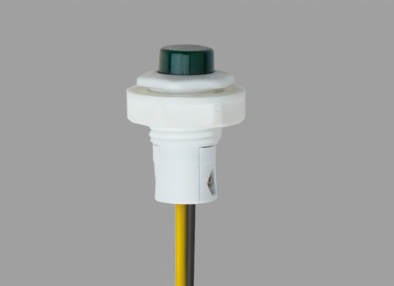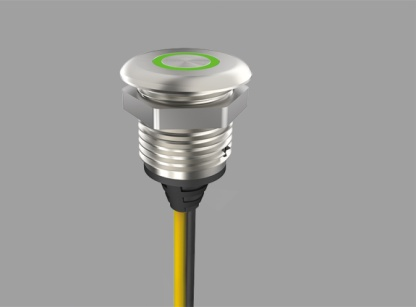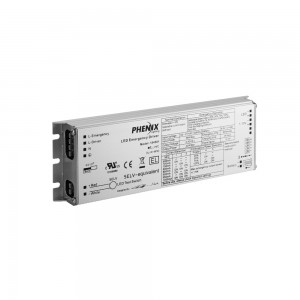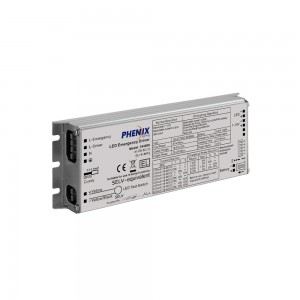COLDPACK LED AC + EMERGENCY DRIVER 184502 184503
1. For normal and emergency operation of LED load in extreme temperature from -40°C to +50°C (-40°F to +122°F), no need an extra LED driver
2. Phenix Lighting's innovative Battery Real-time Temperature Control (BRTC) Technology ensures that the battery can be charged and discharged well even at -40°C and the emergency time is over 90 minutes
3. Preset constant current output for AC driver function
4. Constant power output in emergency mode
5. Slim aluminum housing, built-in heating and insulation battery pack
6. Auto Test
7. Suitable for indoor, dry and damp applications
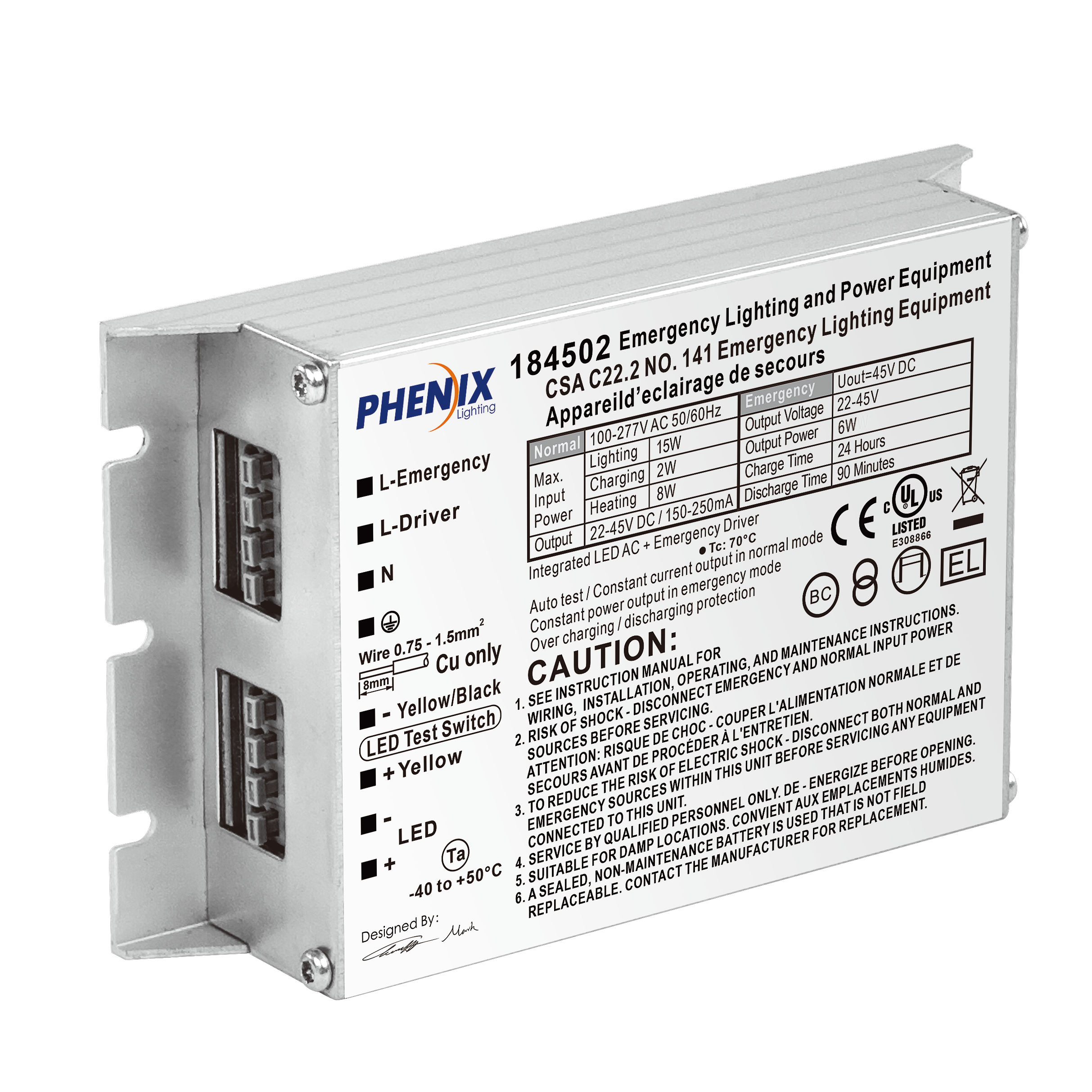
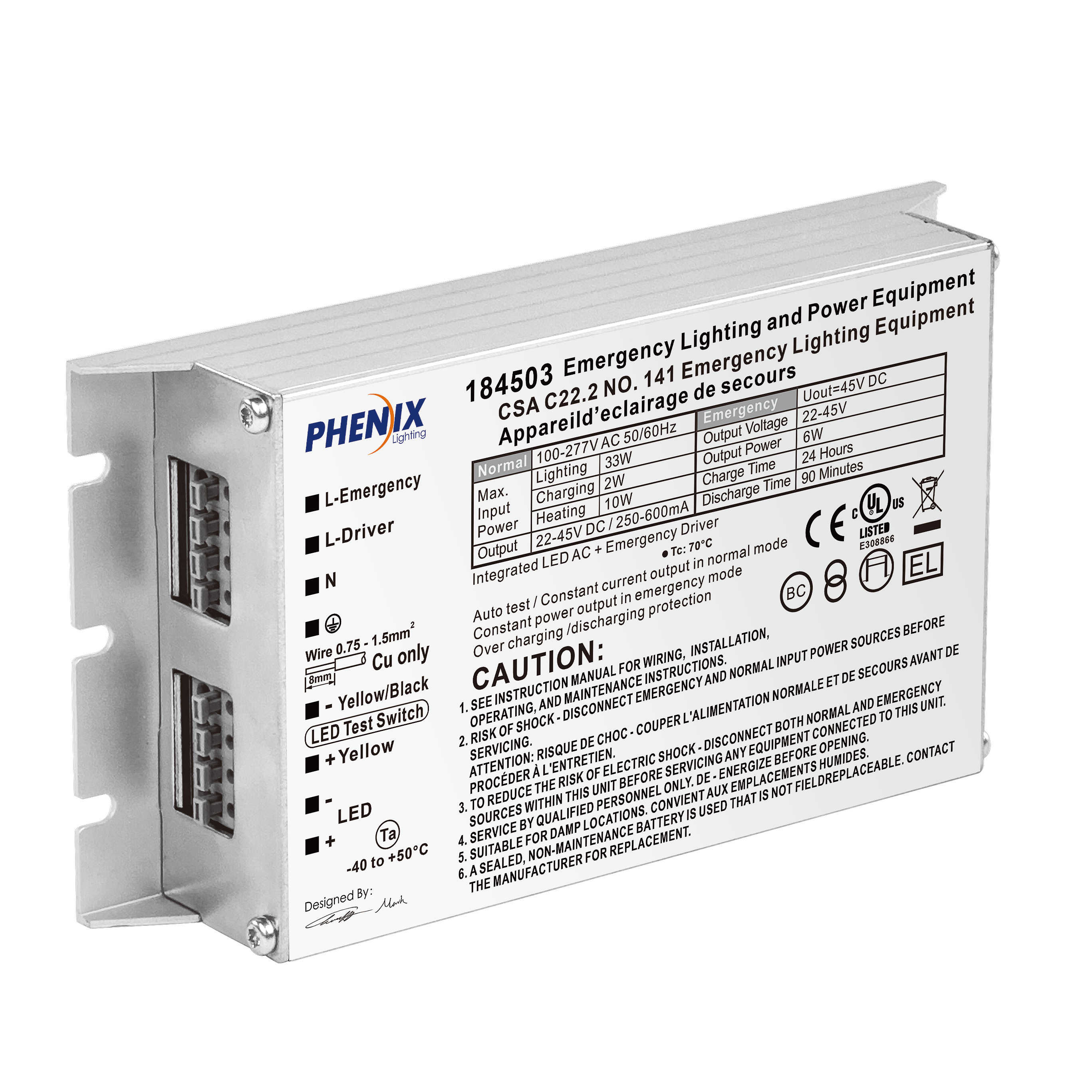
|
Type |
184502 |
184503 |
||
|
Rated voltage |
100-277VAC 50/60Hz |
|||
|
Rated current @100V |
0.24A |
0.43A |
||
|
Operation frequency |
320kHz≥f≥50kHz |
|||
|
Max. Input Power |
Lighting |
14W |
33W |
|
|
|
Charging |
2W |
2W |
|
|
|
Heating |
8W |
8W |
|
|
Power factor |
0.9 @120V |
|||
|
Output voltage |
22-45VDC |
|||
|
Output current |
150-250mA preset |
250-600mA preset |
||
|
Emergency output power |
6W |
|||
|
Battery |
Li-ion |
|||
|
Charging time |
24 Hours |
|||
|
Discharge time |
>90 Minutes |
|||
|
Charging current |
0.13A |
|||
|
Life time |
5 years |
|||
|
Charging cycles |
>500 |
|||
|
Operation temperature |
-40~50°C (-40-122°F) |
|||
|
Efficiency |
75% |
80% |
||
|
Abnormal protection |
Inrush, over voltage, over temperature, charging and discharging, open circuit |
|||
|
Wire |
18AWG/0.75mm2 |
|||
|
EMC/FCC/IC standard |
EN 55015, EN 61547, EN 61000-3-2, EN 61000-3-3,FCC part 15, ICES-005 |
|||
|
Safety standard |
EN 61347-1,EN 61347-2-7, EN 61347-2-13, UL924,CSA C.22.2 No. 141 |
|||
|
Meas. mm [inch] |
L134 [5.28] x W82 [3.23] x H30 [1.18] Mounting center: 124 [4.88] |
L154 [6.06] x W82 [3.23] x H30 [1.18] Mounting center: 144 [5.67] |
||
184502/3
|
Item No. |
L mm [inch] |
M mm [inch] |
W mm [inch] |
H mm [inch] |
|
184502 |
134 [5.28] |
124 [4.88] |
82 [3.23] |
30 [1.18] |
|
184503 |
154 [6.06] |
144 [5.67] |
82 [3.23] |
30 [1.18] |
LED TEST SWITCH (LTS)
LTS-IP20 (Default)
LTS-IP66 (Optional)
ELECTRIC CONNECTION
Use UL18 AWG wire for input and output connection, min rated 300V, 105°C, copper conductor only.
After connection, the conductors shall not be exposed.
Wiring Diagram
OPERATION
When AC power is applied, the LED test switch (LTS) is illuminated, indicating that the batteries are being charged. When AC power fails, the 184401-UFO-MVD automatically switches to emergency power, operating the lighting load at rated emergency power. During power failure, the LTS will be off. When the AC power is restored, the 184401-UFO-MVD switches the system back to normal mode of operation and resumes battery charging. The minimum emergency operation time is 90 minutes. The charging time for a full discharge is 24 hours. A short term discharge test may be conducted after the 184401-UFO-MVD has been charging for 1 hour. Charge for 24 hours before conducting a long term discharge test.
EMERGENCY OUTPUT CONVERSION
The default emergency time is min. 90 minutes. In the normal mode, LTS slowly blinks - ON for 1 second and OFF
for 1 second, while the battery is being charged; After the battery is fully charged, the LTS stays ON. By Pressing
LTS 4 times within 3 seconds in the normal mode can halve the emergency power and extend the emergency time to 180 minutes. In this option, the LTS in the normal mode is slowly blinking: 5 seconds ON, 0.5 seconds OFF.
When the battery is fully charged, the LTS is ON for 5 seconds and breathing for 2.5 seconds
TESTING AND MAINTENANCE
The following Periodic testing is recommended to ensure the system is working correctly.
1. Visually inspect the LED test switch (LTS) monthly. It should be illuminated when AC power is applied.
2. Conduct a 60-second discharge test by switching off the emergency breaker every month. The LTS will be off.
3. Conduct a 90-minute discharge test once per year. The LTS will be off during test.
AUTO TEST
The 184401-UFO-MVD has an Auto Test feature which saves cost by reducing the need for manual testing.
1. Initial Auto Test
When the system is connected properly and powered on, the 184401-UFO-MVD will perform an initial Auto Test. If any abnormal conditions exist, the LTS will blink quickly. Once the abnormal condition is corrected, the LTS will function correctly.
2. Preprogrammed Scheduled Auto Test
a) The unit will conduct the first Monthly Auto Test after 24 hours and up to 7 days after initial power on. Then monthly tests will be performed every 30 days.
b) Annual Auto test will occur every 52 weeks after initial power on.
- Monthly Auto Test
The Monthly Auto Test shall be executed every 30 days, and will test;
Normal to emergency transfer function, emergency, charging and discharging conditions are normal.
Monthly test time is approximately 30 seconds.
- Annual Auto Test
Annual Auto Test will occur every 52 weeks after the initial 24 hours full charge, and will test;
Proper initial battery voltage, 90-minute emergency operation and acceptable battery voltage at the end of the full 90-minute test.
If the Auto Test is interrupted by a power failure, a full 90-minute Auto Test will occur again 24 hours after the power is restored. If the power failure causes the battery to fully discharge, the product will restart the Initial Auto Test and Preprogrammed Scheduled Auto Test.
MANUAL TEST
1. Press the LTS 2 times continuously within 3 seconds to force a 60-second monthly test. After the test is complete, the next (30-day) monthly test will count from this date.
2. Press the LTS 3 times continuously within 3 seconds to force a 90-minute annual test. After the test is completed, the next (52-week) annual test will count from this date.
3. During any manual test, press and hold the LTS for greater than 3 seconds to terminate a manual test. The Preprogrammed Scheduled Auto Test time will not change.
LED TEST SWITCH (LTS) CONDITIONS
LTS Slow Blinking: Normal Charging
LTS On: Battery Fully Charged – Normal Condition
LTS Off: Power Failure
LTS Gradual Change: In Testing Mode
LTS Quickly Blinking: Abnormal Condition – Corrective Action Required
1. To prevent electric shock, switch off the mains power supply until installation is complete and AC input power is supplied to this product.
2. This product requires an un-switched AC power supply of 220-240V, 50/60Hz.
3. Make sure all connections are in accordance with the National or Canadian Electrical code and any local regulations.
4. To reduce the risk of electrical shock, disconnect both normal power, emergency power supplies and unit connector of this product before servicing.
5. For emergency operation of LED, incandescent, fluorescent fixtures and screw-base lamps.
6. Use this product in 0°C minimum, 50°C maximum ambient temperatures (Ta). It can provide minimum 90 minutes illumination under the emergency mode.
7. This product is suitable for use in dry or damp locations. Do not use outdoors. Do not mount it near gas, heaters, air outlets or other hazardous locations.
8. Do not attempt to service the batteries. A sealed, non-maintenance battery is used that is not field replaceable. Contact the manufacturer for information or service.
9. As this product contains batteries, please be sure to store it in an indoor environment of -20°C ~30°C. It must be fully charged and discharged every 6 months from the date of purchase until it is officially put into use, then recharged 30-50% and stored for another 6 months, and so on. If the battery is not used for more than 6 months, it may cause excessive self-discharge of the battery, and the resulting reduction of battery capacity is irreversible. For products with separate battery and emergency module, please disconnect the connection between battery and module for storage. Due to its chemical properties, it is a normal situation for the battery capacity to decline naturally during use. Users should take this into account when choosing products.
10. The use of accessory equipment not recommended by the manufacturer may cause an unsafe condition and void warranty.
11. Do not use this product for other than intended use.
12. Installation and service should be performed by qualified service personnel.
13. This product should be mounted in locations and at heights where it will not readily be subjected to tampering by unauthorized personnel.
14. Ensure product compatibility before final installation. Make sure the polarity is correct when connecting the batteries. Wiring should be strictly in accordance with the wiring diagram, wiring errors will damage the product. A case of safety accident or product failure caused by users’ illegal operation does not belong to the scope of customer complaint acceptance, compensation or product quality assurance.



